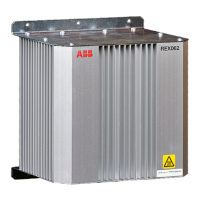• OperationZ2: Operation zone 2 On, Off. If OperationZ1 = Off, all pole-slips with
centre of the electromechanical oscillation within zone 2 are ignored. Default
setting = On.
• tBreaker: Circuit breaker opening time. Use the default value tBreaker = 0.000 s
if unknown. If the value is known, then a value higher than 0.000 is specified, for
example tBreaker = 0.040 s: the out-of-step function gives a trip command
approximately 0.040 seconds before the currents reach their minimum value.
This in order to decrease the stress imposed to the circuit breaker.
• GlobalBaseSel: This setting identifies the Global Base Values Group where
UBase and IBase are defined. In particular: UBase is the voltage at the point
where the Out-of-step protection is connected. If the protection is connected to
the generator output terminals, then UBase is the nominal (rated) phase to phase
voltage of the protected generator. All the resistances and reactances are
measured and displayed referred to voltage Ubase. Observe that ReverseX,
ForwardX, ReverseR, and ForwardR must be given referred to UBase.IBase is
the protected generator nominal (rated) current, if the Out-of-step protection
belongs to a generator protection scheme.
• InvertCTCurr: If the currents fed to the Out-of-step protection are measured on
the protected generator neutral side (LV-side) then inversion is not necessary
(InvertCTCurr = Off), provided that the CT’s star point earthing complies with
ABB recommendations, as it is shown in Table
29. If the currents fed to the Out-
of-step protection are measured on the protected generator terminals side, then
invertion is necessary (InvertCTCurr = On), provided that the CT’s star point
earthing complies with ABB recommendations, as it is shown in Table
29.
8.6 Loss of excitation LEXPDIS
8.6.1 Identification
Function description
IEC 61850
identification
IEC 60617
identification
ANSI/IEEE C37.2
device number
Loss of excitation LEXPDIS
SYMBOL-MM V1 EN
40
8.6.2 Application
There are limits for the loss of excitation of a synchronous machine. A reduction of the
excitation current weakens the electromagnetic coupling between the generator rotor
and stator, hence, the external power system. The machine may lose the synchronism
and starts to operate like an induction machine. Then, the reactive consumption will
increase. Even if the machine does not lose synchronism it may not be acceptable to
1MRK 502 071-UEN - Section 8
Impedance protection
Generator protection REG670 2.2 IEC and Injection equipment REX060, REX061, REX062 281
Application manual

